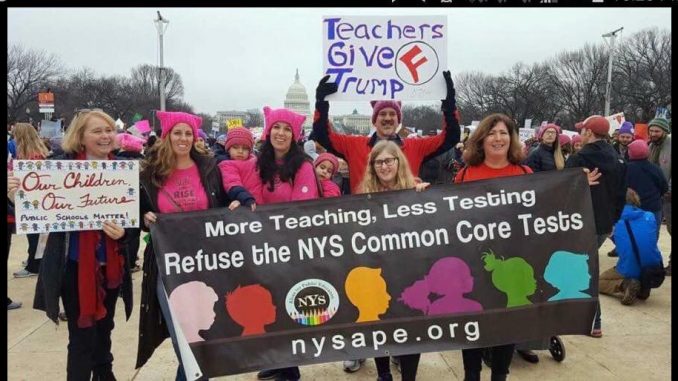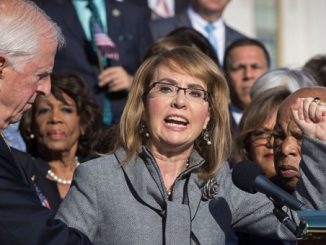
This is ASTRO-TURFING. We knew it.
“Can you believe these kids?” It’s been a recurring theme of the coverage of the Parkland school shooting:
the remarkable effectiveness of the high school students who created a gun control organization in the wake of the massacre. In seemingly no time, the magical kids had organized events ranging from a national march to a mass school walkout, and they’d brought in a million dollars in donations from Oprah Winfrey and George Clooney.
The Miami Herald credited their success to the school’s stellar debate program. The Wall Street Journal said it was because they were born online, and organizing was instinctive.
On February 28, BuzzFeed came out with the actual story: Rep. Debbie Wassermann Schultz aiding in the lobbying in Tallahassee, a teacher’s union organizing the buses that got the kids there, Michael Bloomberg’s groups and the Women’s March working on the upcoming March For Our Lives, MoveOn.org doing social media promotion and (potentially) march logistics, and training for student activists provided by federally funded Planned Parenthood.
The president of the American Federation of Teachers [AFT Randi Weingarten] told BuzzFeed they’re also behind the national school walkout, which journalists had previously assured the public was the sole work of a teenager. (I’d thought teachers were supposed to get kids into school, but maybe that’s just me.)
In other words, the response was professionalized. That’s not surprising, because this is what organization that gets results actually looks like.
It’s not a bunch of magical kids in somebody’s living room.
Nor is it surprising that the professionalization happened right off the bat. Broward County’s teacher’s union is militant, and Rep. Ted Lieu stated on Twitter that his family knows Parkland student activist David Hogg’s family, so there were plenty of opportunities for grown-ups with resources and skills to connect the kids.
That’s before you get to whether any of them had been involved in the Women’s March. According to BuzzFeed, Wassermann Schultz was running on day two.
What’s striking about all this isn’t the organization. If you start reading books about organizing, it’s clear how it all works. But no journalist covering the story wrote about this stuff for two weeks. Instead, every story was about the Parkland kids being magically effective.
On Twitter, I lost track of the number of bluechecks rhapsodizing over how effective the kids’ organizational instincts were. But organizing isn’t instinctive. It’s skilled work; you have to learn how to do it, and it takes really a lot of people. You don’t just get a few magical kids who’re amazing and naturally good at it.
The real tip-off should have been the $500,000 donations from Winfrey and Clooney. Big celebrities don’t give huge money to strangers on a whim. Somebody who knows Winfrey and Clooney called them and asked. But the press’s response was to be ever more impressed with the kids.
For two weeks, journalists abjectly failed in their jobs, which is to tell the public what’s going on. And any of them who had any familiarity with organizing campaigns absolutely knew. Matt Pearce, of the Los Angeles Times, would have been ideally placed to write an excellent article: not only is he an organizer for the Times’s union, he moderated a panel on leftist activism for the LA Times Book Festival and has the appropriate connections in organizing. Instead, he wrote about a school walkout, not what was behind it. (In another article, Pearce defined Delta caving to a pressure campaign’s demands as “finding middle ground.”)
But it’s not just a mainstream media problem. None of the righty outlets writing about Parkland picked up on the clear evidence that professional organizers were backing the Parkland kids, either.
Instead, they objected to the front-and-centering of minor kids as unseemly, which does no good: Lefties aren’t going to listen, and it doesn’t educate the Right to counter.
The closest anyone got was Elizabeth Harrington at the Washington Free Beacon, who noted that Clooney’s publicist was booking the kids’ media interviews pro bono, and said that a friend (not Clooney) had asked him to do it. The result of all this is that the average righty does not understand what’s going on in activism, because all they see is what the press covers. The stuff that’s visible. It’s like expecting people in the Stone Age to grok the Roman army by looking at it. Conspiracy theorists happily fill this ignorance vacuum.
On one hand, sure, the issue with people who believe in crisis actors and various other kinds of conspiracy theories is that they’re susceptible. If they didn’t believe in crisis actors, they’d believe in something else (and they probably do). But on the other hand, I think one reason there’s an opportunity for righty conspiracy types to get all hopped up on goofballs with respect to protests and such is the abject failure of the Righty establishment to explain to its people how protests actually work.
This results in occasional hilarity when the Right tries to organize its own protests. For example, then-Internet celebrity Baked Alaska tried to create pro-Trump flashmobs in Los Angeles during the election. His efforts consisted of posting times and locations online. And that’s it.
You see this attitude often among Righties: “We have the Internet! We’ll post a notice and people will show up!” Well, no; they won’t. It’s not that Baked Alaska needed a magical kid, because there are no magical kids. There’s just hard work, and our press and politicos do everyone a disservice when they pretend otherwise.
Here’s an example of how to turn out people, cribbed from “Organizing for Social Change,” the activist manual published by the Midwest Academy, which has been around since 1973 and has trained over 30,000 activists, some of whom went on to found their own training schools.
Say you run an organization that wants to impress a city councilman, and you’ve landed a meeting. You want your group to look bigger than it is. You’ve got 15 dedicated people you know will go, but you want to show the councilman 60 people.
The first thing you do is get 10 people from other groups (you do know other ideologically aligned groups in the area, right?). That leaves 35 people. To get them, you don’t post an ad on Craigslist. You look in your database of people who’ve signed your petitions or whatever. Call and ask them to come.
If they say yes, call them again a day or two in advance to confirm. Of the people who say yes twice, only half will actually show up. So you need 70 people to say yes twice. Expect to make seven times that number of phone calls to get them. That’s 490 five-minute phone calls, which breaks down to five people a night making phone calls for five straight nights.
It’s not magical kids, and it’s not George Soros sprinkling money around. It’s hard work by people who’ve trained to do it. That’s a little more work than posting an announcement on Facebook. And that’s organizing. It’s not magical kids, and it’s not George Soros sprinkling money around.
It’s hard work by people who’ve trained to do it.
Now that the organizations are more open about their involvement, at some point the Parkland kids will go into the background a bit in media exposure, the same way Deray and Linda Sarsour did. That’s part of how organizing fame works these days: Two Minutes’ Heroes, in frequent rotation. But the problem remains: until the press covers organizing campaigns accurately, organizers will be able to punch above their weight politically even if they don’t win every election.
In his excellent book “Hegemony How-To,” leftist organizer Jonathan Smucker wrote, “Power tends to appear magical to those who have less of it, and mechanical to those who are accustomed to wielding it instrumentally.” Or, for that matter, to even seeing it instrumentally.
For two weeks, journalists treated power as if it were magical. It’s not. It’s mechanical. The people organizing the response to Parkland, and a host of other causes, know that. So should you.
-Thinkologist






Be the first to comment